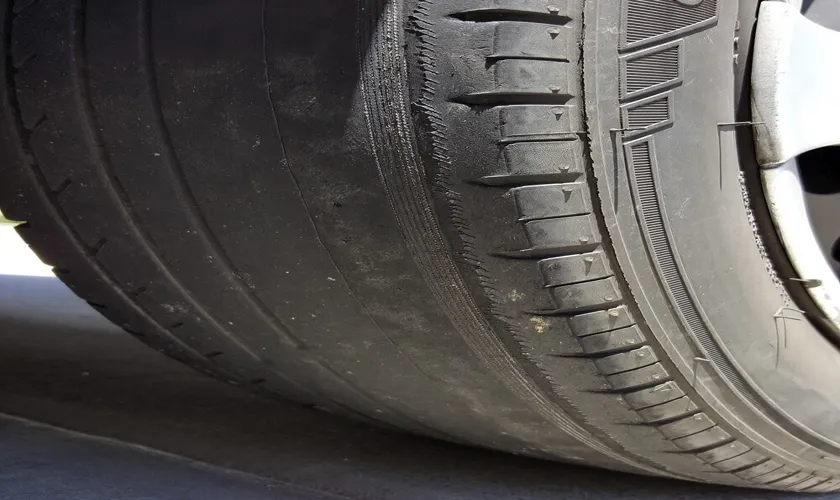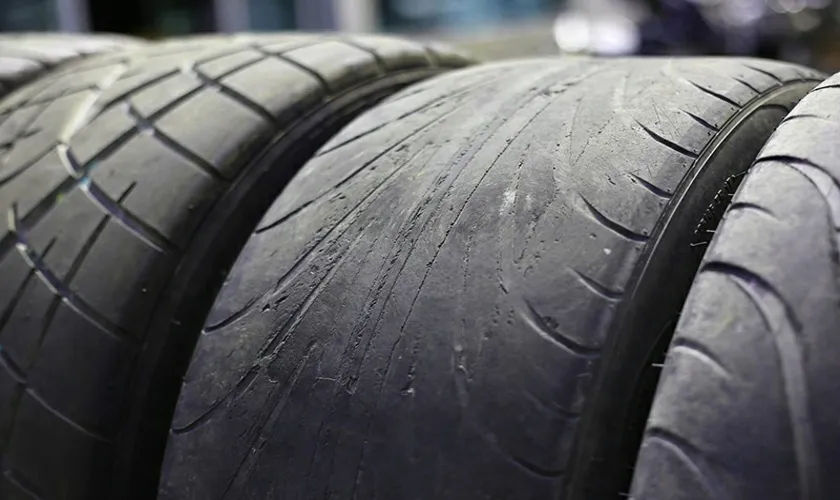Have you ever wondered how long your bald tire will last before it completely wears out? Well, the answer may not be as straightforward as you’d think. A tire’s lifespan depends on various factors such as the type of tire, the driving conditions, the vehicle’s weight, and the driver’s habits. Typically, a tire’s tread depth should not fall below 2/32 of an inch for it to be considered roadworthy.
However, some tires may not even last that long and require replacing before reaching the minimum tread depth. That’s because tires wear out faster when subjected to harsh driving conditions such as extreme temperatures, rough roads, and excessive loads. An old tire, even with relatively good tread depth, may pose a danger to the driver and other road users.
The rubber compound that tires are made of loses its elasticity with time, reducing its grip on the road. Also, bald tires increase the chances of hydroplaning on wet surfaces, leading to loss of vehicle control. In essence, a bald tire may last anywhere from a few weeks to several months, depending on the driving conditions and tire quality.
The best way to ensure optimal tire life is to maintain proper inflation levels, rotate tires regularly, and drive cautiously to avoid unnecessary wear and tear. So if you notice your tire is balding, it’s best to get it replaced immediately for your safety and that of others on the road.
Table of Contents
Bald Tires: Definition and Causes
Have you ever wondered how long a bald tire can last? To start, let’s talk about what we mean by “bald tire.” A tire is considered bald when the tread is worn down to the point where it is no longer able to provide proper traction on the road. This can be caused by a variety of factors, such as driving on rough terrain or just not replacing the tires in a timely manner.
Essentially, bald tires are dangerous tires. They increase the risk of hydroplaning, sliding, and even blowing out. So how long can a bald tire last? The simple answer is: not very long.
In fact, bald tires can fail at any time and without warning. It’s impossible to predict exactly when a bald tire will give out, but it’s always best to err on the side of caution and replace them as soon as possible. The consequences of driving on bald tires can be severe, so don’t take the risk.
Remember the importance of regular tire maintenance and tread depth checks in order to keep yourself, your passengers, and other drivers safe on the road.
What is a Bald Tire?
Bald tires are those with little to no tread depth, which is the amount of rubber on the tire’s surface that comes into contact with the road. This can be caused by a number of factors, including wear and tear from everyday use, over-inflation, under-inflation, and driving on rough or abrasive terrain. When a tire is bald, it loses its ability to grip the road properly, which increases the risk of hydroplaning, skidding, and losing control of the vehicle.
Additionally, bald tires are more prone to punctures and blowouts, which can be dangerous and even catastrophic while driving. To avoid bald tires, it’s essential to regularly inspect your tires for signs of wear, routinely check the air pressure, and replace them when the tread depth falls below the legal limit. Don’t take chances with your safety on the road – keep your tires in top condition and always drive defensively.

What Causes Tires to Go Bald?
Tires are undoubtedly the most important part of any vehicle’s safety and performance. When we talk about tires, the term “bald” is often used to describe a worn-out tire that has lost most of its tread depth. Bald tires pose a significant risk to drivers as they can become slippery and lose traction on the road.
But what causes tires to go bald? There are several factors responsible for this. The most common one is wear and tear due to extended use and exposure to rough road surfaces. Other factors include over/underinflation, misaligned wheels, damaged suspension systems, and driving at high speeds.
Regular tire maintenance can help you avoid bald tires and ensure a safe and smooth driving experience. So, always keep an eye on your tire’s tread and get them inspected by a professional mechanic regularly.
Signs That Your Tire is Bald
If you’ve ever wondered how long will a bald tire last, you’re not alone. It’s important to recognize the signs that your tire is bald, as failing to do so can result in dangerous driving conditions. One of the main signs of a bald tire is a lack of tread depth.
This is typically the result of excessive wear and tear, which can be caused by a variety of factors including improper wheel alignment, overinflation of the tire, and lack of rotation. Other signs of a bald tire include cracking, bulging, or a vibration while driving. It’s important to replace a bald tire as soon as possible to ensure your safety on the road.
Remember, neglecting to replace a bald tire can lead to serious consequences, including accidents and injuries.
Check the Tread Depth
One issue that’s easy to overlook with your tires is the tread depth. Your tread is what helps you grip the road, and when it wears down, your tire becomes bald. A bald tire won’t provide the same level of traction, which can be dangerous in wet or slippery conditions.
So, how do you know if your tire is bald? One of the easiest ways is to check the tread depth. If it’s less than 2/32 of an inch, your tire is legally bald in most states. You can also look for other signs of wear, like cracks, bulges, or uneven wear patterns.
If you notice any of these signs, it’s time to replace your tire. Remember, your tire protects you and your passengers, so it’s important to take care of it!
Look for Wear Bars
If you’re concerned about the condition of your tires, it’s important to know when they’re bald. A bald tire is one that can’t provide optimal traction on the road, which can put you and others in danger. One way to check for baldness is to look for wear bars.
These small, raised sections of rubber that run perpendicular to the tread of your tire indicate the point at which your tire is legally bald. If the tread is level with the wear bar, it’s time to replace your tire. Additionally, you can use the penny test to check for baldness.
Simply insert a penny into the tread groove with Lincoln’s head upside-down. If you can see the top of his head, your tread is too worn and it’s time for a replacement. Don’t ignore the signs of bald tires – they can compromise your safety on the road.
Observe the Overall Appearance of the Tire
When it comes to maintaining your car, one of the most important things you can do is keep a close eye on the condition of your tires. Over time, your tires will wear down, which can lead to decreased performance and even dangerous driving conditions. One clear sign that your tire is bald is if you observe the overall appearance of the tire.
Bald tires will have smooth, worn-down tread, which can be seen by closely inspecting the surface of the tire. Additionally, if the tread has worn down to the point where it is flush with the rubber casing of the tire, this is a clear indication that it is time to replace the tire. It’s important to keep in mind that bald tires can make your car more difficult to control, especially in wet or slippery conditions, so it’s crucial to check your tires regularly to ensure they are in good condition.
By staying on top of your tire maintenance, you can help keep yourself and your passengers safe on the road.
Factors That Affect How Long a Bald Tire Will Last
“How long will a bald tire last?” is a common question among vehicle owners. The lifespan of a bald tire can vary due to a number of factors. One of the most important considerations is the tire’s age.
Even if there is plenty of tread left on an older tire, it may still be more susceptible to failure due to dry rot or other issues. Driving habits can also have a significant impact on tire life. Frequent hard braking, accelerating, and extreme turns can cause excessive wear and tear on tires, leading to a shorter lifespan.
Additionally, environmental factors such as heat, cold, and exposure to sunlight can all contribute to a tire’s deterioration over time. Ultimately, it is important to regularly inspect tires for signs of wear and replace them as needed to ensure optimal safety and performance on the road.
Driving Habits
Bald tires are a danger on the road, but it’s not enough to just replace them when the tread wears down. There are other factors that can affect how long a bald tire will last. Driving habits play a big role in this – if you frequently accelerate hard, brake suddenly, or take turns at high speeds, your tires will wear down much faster than if you’re a more cautious driver.
But it’s not just about how you drive – the type of road you drive on also matters. Rough roads or those with lots of potholes can cause your tires to wear down faster, whether they’re already bald or not. Other factors that can affect tire wear include temperature and inflation level, so it’s important to monitor these regularly.
Ultimately, it’s best not to let your tires reach the point of baldness in the first place, but if you do, be sure to replace them as soon as possible to prevent accidents on the road.
Road Conditions
Road Conditions One of the most critical factors that determine how long a bald tire will last is the road conditions on which the tire is being used. Uneven or poorly maintained roads can increase the wear on the tires, and can lead to an increased likelihood of punctures or blowouts. Harsh driving conditions, such as gravel roads, can also jeopardize the lifespan of the tire.
It’s imperative to be cautious when driving during inclement weather conditions, such as heavy rain or snow, which can negatively affect the tire’s longevity. Potholes, bumps and other obstacles can stress the tires beyond repair. It is important to remember that the lifespan of a tire is not solely based on the tire’s construction or material.
Rather, the road conditions and the driving habits of the motorist also play a critical role in the tire’s durability. Be sure to steer clear of rough roads, poorly maintained infrastructure, and other obstacles to ensure the longest possible lifespan for your tires.
Climate and Temperature
Climate and Temperature As you drive around in your car, there are a few things to consider when it comes to the longevity of your tires. One of the main factors is the climate and temperature you drive in. Extreme heat and cold can both decrease the life of your tires as they can cause the rubber to deteriorate.
Additionally, high levels of humidity can create moisture that can also be detrimental to the lifespan of your tires. On the flip side, if you typically drive in mild temperatures with moderate humidity levels, your tires will likely last longer. It’s important to monitor the temperatures and climate you drive in and take proper care of your tires by keeping them inflated, rotating them regularly, and checking their tread depth.
These precautions can help extend the life of your bald tires, even in less than ideal driving conditions.
When to Replace a Bald Tire
If you’re wondering how long a bald tire can last, the answer is not very long. Bald tires are those that have worn down to the point where the tread has become very shallow, or worn away completely, leaving the tire smooth and unsafe to drive on. Driving on a bald tire can be incredibly dangerous, as it can lead to loss of control on wet or slippery roads, and cause accidents.
In general, tires should be replaced when the tread depth has worn down to 2/32 of an inch. To check your tires, place a penny with Lincoln’s head upside down in the groove of the tire, and if you can see the top of his head, it’s time to replace your tire. Don’t wait until it’s too late, as the cost of a new tire is much less than the cost of an accident or injury resulting from driving on bald tires.
Stay safe on the road by keeping your tires in good condition and replacing them as needed.
The Legal Minimum Tread Depth
When it comes to maintaining a safe vehicle, one aspect that should never be overlooked is the tread depth of your tires. The legal minimum tread depth is 2/32 of an inch, but it is recommended to replace bald tires at 4/32 of an inch to ensure proper traction on wet or slippery roads. One way to check the tread depth of your tires is to insert a penny with Lincoln’s head facing down into the tread.
If the top of Lincoln’s head is fully visible, it is time to replace the tire. Adequate tread depth helps your tires grip the road and reduces the risk of hydroplaning, especially in rainy conditions. It is important to regularly check the tread depth of your tires and replace them when necessary to ensure the safety of your vehicle and its occupants.
Don’t wait until it’s too late, take action now and protect yourself on the road.
Other Signs it’s Time to Replace a Bald Tire
If you’re wondering when to replace a bald tire, the answer isn’t as simple as it may seem. While a lack of tread depth is a pretty clear indication that it’s time for new tires, there are other signs to look out for as well. For example, if you notice cracking, blistering, or bulging anywhere on your tire, it’s time to replace it immediately.
Additionally, if your car is veering to one side while driving, or if you feel an unusual vibration or thumping, it could be a sign that your tire is wearing unevenly and needs to be replaced. Remember, your tires are what keep you safely connected to the road, so it’s important to pay attention to any signs of wear and tear and replace them before it’s too late.
Conclusion and Safety Tips
In the game of tire life, the bald ones lose every time. While it may be tempting to push your luck with a well-worn tire, the truth is that bald tires lack the grip and stability needed to keep you safe on the road. So, to answer the question of how long will a bald tire last, the only logical answer is not very long at all.
Don’t gamble with your safety – invest in new tires and enjoy the ride with peace of mind.”
FAQs
Can driving on bald tires be dangerous?
Yes, driving on bald tires is dangerous as it reduces traction and can increase the risk of accidents.
How can I tell if my tire is bald?
The easiest way to check your tire’s condition is by using a penny: insert it into the tire’s tread with Lincoln’s head down; if you can see the top of his head, your tire needs to be replaced.
Can I still pass inspection with bald tires?
No, most states require that tires have a minimum tread depth of 2/32 of an inch to pass inspection.
How long can I drive on bald tires?
It’s not recommended to drive on bald tires as it can be hazardous. If you’re in an emergency, try to limit your speed and travel distance as much as possible.
Will driving on bald tires damage my car?
Yes, driving on bald tires can wear out your car’s suspension and steering components as it puts more stress on them.
Can I replace just one bald tire or should I replace them all?
It’s generally recommended to replace all four tires at once to maintain even wear and avoid future issues.
How can I extend my tire’s lifespan and prevent them from becoming bald quickly?
Regular maintenance, proper inflation, and avoiding harsh driving conditions can help extend your tire’s lifespan and prevent them from becoming bald too soon.



